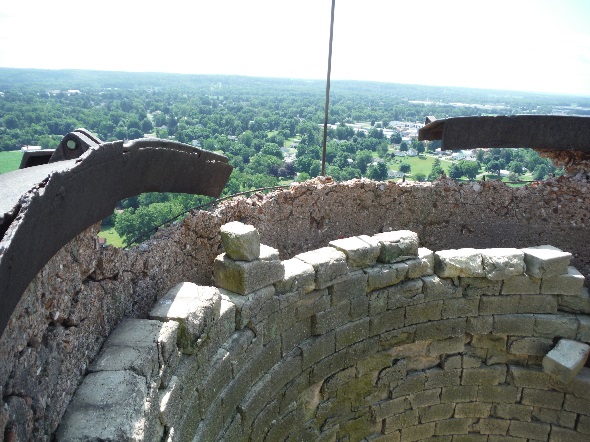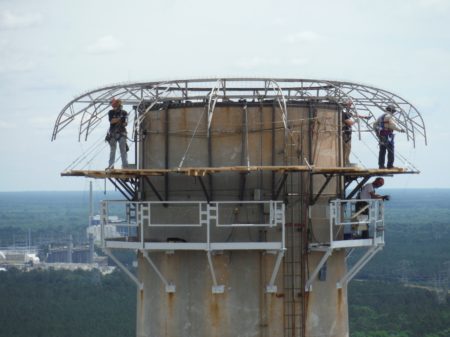Updating an Existing Lightning Protection System

Example of Chimney damage after lightning
strikes.
Lightning strikes to industrial chimneys, stacks and other tall structures are commonly considered inevitable. Every year these structures take a beating from the weather, and few weather phenomena are more destructive than lightning. Not only does a lightning strike affect the immediate area of the structure, but potentially any other equipment, personnel or electrically-sensitive instruments and equipment in the surrounding area.
Industrial Access, Inc. was hired to remedy this problem on a customer’s stack located in a coastal region of the Southeast. Working for the system designer and supplier, Lightning Eliminators and Consultants, Inc., Industrial Access updated the existing lightning protection system (“LPS”) on this 350-foot concrete chimney. The system is known as a “Charge Transfer System” (CTS). The system provided by LEC is trade named “Dissipation Array System” (DAS).
This system works by reducing the static charge which builds up on the chimney and surrounding ground, which is caused by certain cloud formations moving overhead. That build-up, once strong enough, can lead to an electrostatic discharge – a lightning strike to the chimney itself.
Traditionally, lightning protection systems have relied on air terminals (“lightning rods”) extending above the top of the chimney or stack to provide a point where static electricity from the structure and the ground accumulates and flows upward through the nearest, highest point as a concentrated stream of charged particles. The clouds above carry an opposite electrical charge. When the two opposites “connect” they complete an electrical circuit in the air which we call lightning.
This type of LPS installation is designed to attract the lightning to that very point, then conduct it to ground by means of a grounding wire. This brings too much high energy and high frequency currents too close to sensitive electronics and electrical systems in facilities such as this (50 percent of the lightning strikes in the U.S. are 30,000 amps or greater and at frequencies of 200 kHz to 20 MHz).
By reducing the buildup of static electricity gradually and continuously over a wider “footprint” the Lightning Eliminators system prevents the concentrated build-up of energy at one point – keeping it below the threshold required for a lightning strike to occur. Lowering the static potential of the chimney with the DAS greatly reduces the likelihood of a direct strike occurring, allowing the lightning to terminate at some other point where the high static condition remains away from the chimney.
The original DAS array was installed on this chimney in 2002. Over time, the conductive wiring must be replaced due to weathering and wear. The work completed on this project consisted of removing and replacing the existing LPS array wiring from the rigid metal frame at the top of the stack. The wiring is installed as a continuous loop which spirals around the frame and connects to the LPS system ground wire.
In the past, LEC has relied on the use of a crane to service DAS arrays on stacks of up to about 200’ feet in height; and for chimneys taller than 200,’ helicopter lifts were usually required. The arrays would be partially disassembled to the extent they could be safely lowered to the ground, section-by-section. Once removed from the stack, the required maintenance and repairs would be performed, including tasks such as re-wiring the array. The sections of the DAS were then lifted back into place and re-installed. Because removing the DAS structure from the stack for repairs and then replacing it requires extended close proximity to the flue opening, stacks would need to be offline for repairs to the DAS.

Industrial Access technicians use temporary bracket scaffolding to work on a Lightning Eliminators system for a 50-foot concrete chimney.
The rope access capabilities of Industrial Access helped LEC to challenge the accepted methods and significantly reduce project cost by eliminating the need for crane or helicopter lifts. Through their ability to gain access directly to the DAS structure in-place, IA technicians were able to perform the conductive wire replacement at elevation, without having to work above the flue opening. This gives the LEC team the option of scheduling repairs for their customers even with the chimney on line.
Lightning protection systems can be a life-saver to stacks, chimneys and surrounding equipment when installed and maintained correctly. With the addition rope-access services for installation and maintenance, Stack and Chimney owners now have even more flexibility to keep their systems up-to-date and functional.



